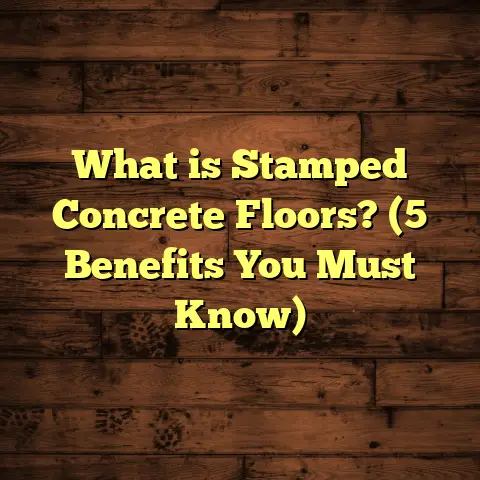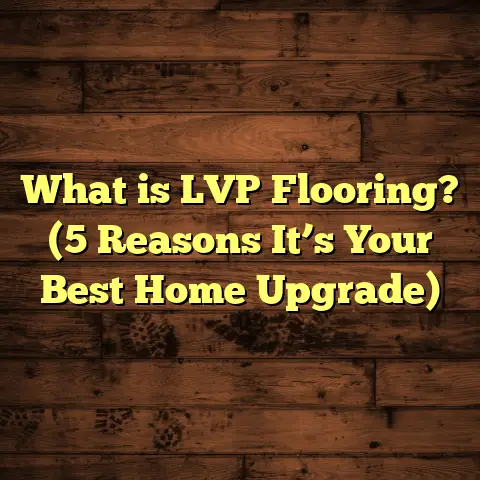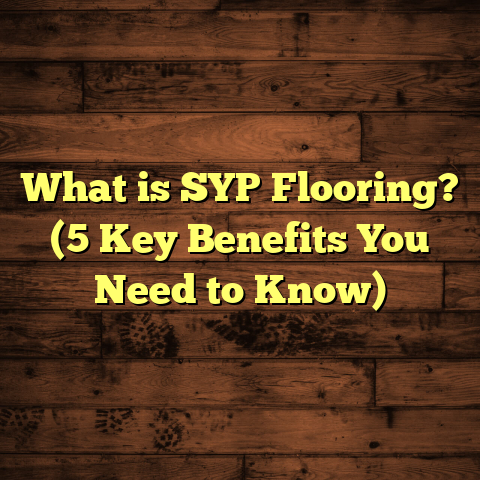What is Recommended Under Solid Wood Flooring? (5 Essential Tips)
I still remember walking into my grandparents’ farmhouse as a kid. The smell of wood, the gentle squeak and warmth of those solid hardwood floors beneath my feet—it felt like stepping into a story, a place made to last. Those floors weren’t just decoration; they were part of the home’s soul. Now, years later as a flooring contractor, whenever I get asked, “What goes under solid wood flooring?” I smile because I know how important the answer is for anyone hoping to create something lasting and beautiful.
If you’re thinking about installing solid wood flooring or just curious what lies beneath those gorgeous planks, pull up a chair. I’m going to walk you through everything I’ve learned — from subfloors and underlayment to moisture barriers and nailing techniques. You’ll get real numbers, stories from the field, and practical tips I wish every homeowner knew before laying down their hardwood.
What Is Recommended Under Solid Wood Flooring?
In simple terms, what goes under solid wood flooring are the layers that support and protect the hardwood itself. These layers include the subfloor, underlayment, and sometimes a moisture barrier — all working together to provide a stable base, control moisture, reduce noise, and improve comfort.
Solid wood flooring isn’t just nailed or glued onto any surface. It requires a foundation designed to handle its natural characteristics—like expansion and contraction due to humidity—and to protect it from environmental damage.
The importance of these layers can’t be overstated. I’ve seen floors warp, squeak, and degrade prematurely simply because the right steps weren’t taken underneath. Let me break down the components one by one.
Subfloor: The Structural Base
Think of the subfloor as the backbone of your hardwood floor. It holds everything up and distributes weight evenly across the joists or foundation below. Without a strong subfloor, your hardwood won’t perform well.
In most homes in North America, the subfloor is made from plywood or oriented strand board (OSB) panels. Plywood is generally preferred because it offers better moisture resistance and doesn’t swell as much as OSB when wet.
The thickness of this subfloor is usually 3/4 inch (19 mm) for residential floors. This thickness provides enough rigidity so that when you walk across, you don’t feel any bounce or flex underfoot. For floors over joists spaced 16 inches apart (the standard), 3/4-inch plywood nailed or screwed down tightly works perfectly.
Here’s a quick example from my experience: On a project in Minneapolis, the builder used 1/2-inch plywood over joists spaced 24 inches apart to save money. Within six months, the homeowners reported creaking floors and visible gaps appearing in their newly installed oak hardwood. We had to add another plywood layer to bring it up to 3/4 inch thickness and reduce joist spacing with sister joists — delaying the project by weeks and adding thousands in cost.
That’s why I always recommend confirming joist spacing and subfloor thickness before buying your hardwood planks.
Another factor is the type of subfloor panels: tongue-and-groove plywood panels fit together tightly, minimizing movement between boards. This helps reduce squeaks over time.
Underlayment: The Cushion and Protector
Underlayment is the layer between your hardwood floor and the subfloor that provides several benefits:
- Moisture protection
- Sound insulation
- Slight cushioning underfoot
- A smooth surface for installation
For traditional nail-down hardwood floors, commonly used underlayment is 15-pound felt paper or rosin paper. These papers act as a moisture retarder and reduce friction as the wood expands and contracts seasonally.
In homes built before 1980 with wooden subfloors, I almost always recommend felt paper. It’s cheap (usually around $0.10-$0.25 per square foot) and effective for preventing squeaks caused by wood rubbing against plywood.
If you’re going with glue-down hardwood or engineered wood flooring, you might consider cork or foam underlayments instead. Cork underlayment offers great soundproofing qualities and has natural moisture resistance. Foam pads provide some cushion but must be paired with a vapor barrier if moisture is a concern.
On one apartment project in Seattle, switching from felt paper to cork underlayment cut footstep noise by about 20%, which was a big win for tenants in adjacent units.
Moisture Barriers: The Unsung Heroes
Moisture is one of the biggest threats to solid wood flooring. Even if your home feels dry, moisture vapor can rise through concrete slabs or crawl spaces and cause serious damage over time—like cupping, warping, or mold.
If you’re installing solid wood flooring over a concrete slab (common in basements or slab-on-grade foundations), I always insist on installing a 6-mil polyethylene vapor barrier beneath the underlayment.
This thin plastic sheet blocks moisture vapor from reaching your wood floor. Skipping this step often leads to costly repairs down the road.
A story from Florida comes to mind: a homeowner had brand-new oak floors installed over a concrete slab without a vapor barrier. Within two years, large sections of flooring began cupping severely due to moisture buildup underneath. The fix was expensive—removing sections of floor, installing vapor barriers, and allowing proper drying time before reinstalling or replacing boards.
If you have wooden subfloors over crawl spaces or basements, ensure those spaces are properly ventilated or even consider adding insulation plus a vapor barrier on the crawl space ground.
Five Essential Tips for What Goes Under Your Solid Wood Flooring
I want to share five essential tips based on my years in the field that will help anyone planning solid wood floor installation get it right from the ground up.
1. Measure Subfloor Flatness Precisely
Before you even pick out your hardwood planks, check how flat your subfloor is.
Why? Because hardwood flooring needs a flat surface to avoid gaps, uneven wear, or squeaking noises later on.
The industry standard says no more than 3/16-inch deviation in flatness over 10 feet — that’s about the thickness of two stacked nickels.
I carry a straightedge or laser level on every job site to measure this myself. If there are bumps or dips beyond this tolerance, I recommend grinding down high spots or using a floor leveling compound on low areas.
For example, on a recent job in Denver’s high-altitude climate, we had to grind down raised concrete spots before installing plywood subfloor panels. This prep added two days but eliminated squeaks and uneven boards later.
Without addressing subfloor flatness upfront, you might see hardwood boards rocking when walked on or gaps forming between planks after seasonal expansion and contraction.
2. Match Subfloor Material to Your Climate and Home Type
Choosing between plywood and OSB subfloors often depends on budget and location but can impact your floor’s lifespan.
Plywood is more water-resistant and less prone to swelling than OSB panels. In areas with higher humidity like coastal North Carolina or Louisiana, marine-grade plywood is often worth the extra cost (about $2 – $3 per sq ft) because it resists moisture damage better.
In older homes with original pine plank subfloors, you might need to add plywood layers on top for stability and fastener holding power.
During renovations in Boston’s historic district, we added 3/4-inch plywood over century-old pine plank subfloors before installing reclaimed oak floors. This ensured consistent fastening points and prevented future squeaks.
3. Pick Underlayment Based on Installation Type and Priorities
Nail-down hardwood floors work best with felt paper underlayment which provides moisture resistance with minimal cushioning.
If your installation calls for glue-down hardwood or engineered wood floors, cork or foam underlayment can add soundproofing and comfort but check manufacturer guidelines for compatibility.
For floating floors — rare for solid wood but common for engineered products — foam or cork underlayments with integrated vapor barriers are typical choices.
A case study from Seattle showed that switching from felt paper to cork underlayment reduced footstep noise by approximately 20%, greatly improving tenant satisfaction in multi-unit buildings.
4. Test Moisture Content Before Installation
Moisture content differences between your hardwood boards and subfloor can cause warping or gaps after installation.
Using a reliable moisture meter (costing around $50-$150), measure both the wood floor material and subfloor before installation.
The ideal moisture content for hardwood flooring ranges from 6% to 9%, with subfloor moisture within 2% of the hardwood boards’ reading.
If the difference exceeds this range, delay installation until materials acclimate naturally in the home environment for at least 3-5 days (longer if humid).
Failing to do this has led many homeowners I’ve worked with into problems like cupping or splitting within months after installation.
5. Leave Proper Expansion Gaps & Use Correct Nailing
Solid wood expands and contracts with seasonal humidity changes — usually around 1/4 inch per 10 feet of length.
Leaving an expansion gap around all walls (typically 3/8 inch) allows the floor room to move without buckling.
Also, use ring-shank nails spaced every 6-8 inches along each tongue of the board for secure fastening that prevents squeaks but doesn’t split wood fibers.
On a custom cabin build in Montana with heavy winter drying cycles, following these practices kept floors silent and stable through harsh seasons.
A Real-Life Example: When Underneath Matters Most
One client called me after their newly installed walnut floor buckled badly within months. They had invested thousands into beautiful flooring but were devastated by visible gaps and cupping boards.
After inspection, I found they had no vapor barrier installed over their concrete slab foundation—only plywood subfloor with no moisture protection underneath—and no felt paper underlayment either.
To fix it we removed damaged boards, installed a polyethylene vapor barrier plus felt paper on top of their plywood subfloor, then reinstalled walnut planks using proper nailing techniques with expansion gaps left intact.
That job was an eye-opener about how skipping what’s beneath can cost dearly later in repairs and stress.
How Much Should You Budget for Subfloor & Underlayment?
Here’s a rough cost breakdown based on multiple projects across different U.S. regions:
| Item | Typical Cost per Sq Ft | Notes |
|---|---|---|
| Plywood Subfloor (3/4 inch) | $1.50 – $2.50 | Varies by grade & location |
| Felt Paper Underlayment | $0.10 – $0.25 | Affordable moisture retarder |
| Cork Underlayment | $0.75 – $1.50 | Adds sound insulation |
| Polyethylene Vapor Barrier | $0.05 – $0.15 | Essential over concrete slabs |
| Labor for Prep & Installation | $2.00 – $4.00 | Depends on complexity & region |
For example, preparing a 1,000 sq ft room with plywood subfloor replacement plus felt paper underlayment might run between $3,000 – $6,000 including labor before hardwood is even laid down.
Adding cork underlayment or vapor barriers can increase costs but are smart investments for longevity and comfort.
Beyond Materials: Other Factors That Impact Flooring Success
While the layers beneath your floor are critical, don’t forget:
- Acclimation: Hardwood should acclimate in your home environment 3-5 days before installation.
- Climate control: Keep humidity levels stable inside your home (between 30-50%) with humidifiers/dehumidifiers as needed.
- Professional inspection: Have your subfloor inspected by an expert before installation.
- Maintenance plan: Regular cleaning and humidity monitoring protect your investment long term.
Wrapping Up: Why What’s Under Your Floor Matters So Much
When you think about solid wood flooring, it’s easy to focus just on the top layer—the color, grain pattern, finish—but what lies beneath defines how well your floor performs over years or decades.
From sturdy tongue-and-groove plywood subfloors nailed tight over properly spaced joists…
To moisture barriers protecting against hidden damage…
To felt paper cushioning nails while allowing breathability…
All these layers work quietly beneath your feet but make a huge difference in comfort, sound control, durability, and beauty retention.
I hope these insights help you approach your own flooring project with confidence—or at least give you some new questions to ask when hiring contractors or buying materials!
If you want help figuring out what fits your space best—or want me to review your plans—I’m always here for advice based on real experience and data-backed practices.
Have you encountered any challenges with your floors? Or are you planning something exciting soon? Let’s chat!





